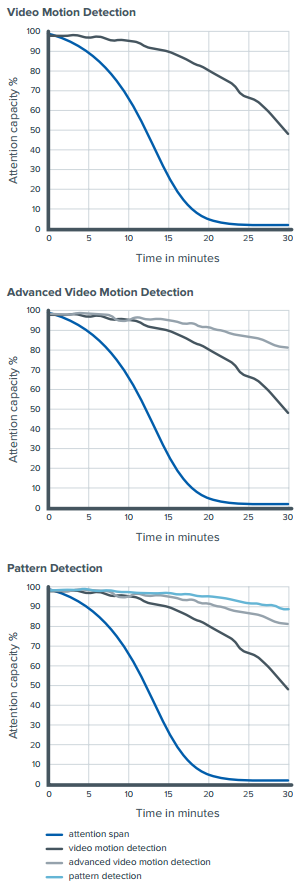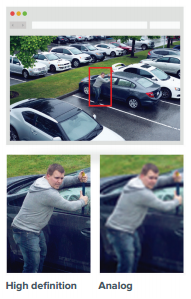 ×
×
 The human brain has limited attention span capabilities. A 1999 study (Green, 1999) found that after 20 minutes, guards watching a video scene will miss up to 95 percent of all activity. Leveraging advancements in video pattern detection, video analytics technology addresses this issue and has comprehensively evolved from being a strictly forensic tool into a powerful proactive solution. Paired with high-definition imaging, HD analytics provides security operators with highly accurate alerts and clear image detail, enhancing their ability to effectively intervene and take action when an incident occurs.
The human brain has limited attention span capabilities. A 1999 study (Green, 1999) found that after 20 minutes, guards watching a video scene will miss up to 95 percent of all activity. Leveraging advancements in video pattern detection, video analytics technology addresses this issue and has comprehensively evolved from being a strictly forensic tool into a powerful proactive solution. Paired with high-definition imaging, HD analytics provides security operators with highly accurate alerts and clear image detail, enhancing their ability to effectively intervene and take action when an incident occurs.
Artificial intelligence pioneer, Herb Simon stated, “A wealth of information creates a poverty of attention.” Simon noted that most technology systems were focused on providing as much information as possible without taking the human attention span into consideration. Consequently, these systems provided a surplus of information to people, when what was needed were systems that filtered out irrelevant information and, highlighted items of interest (Simon 1996).
What Herb Simon was describing was the theory of attention economics; an approach to the management of information that treats human attention as a scarce commodity and a limiting factor in the absorption of information. The attention economics theory supports the creation of systems that take attention capabilities into consideration in their design, creating filters to ensure the first content a user is presented with is relevant and of interest.
 Based on the theory of attention economics, most security control centers and corresponding video surveillance systems today present security personnel with a wealth of information, leading to a poverty of attention. Several studies have shown a disturbing trend in operator performance:
Based on the theory of attention economics, most security control centers and corresponding video surveillance systems today present security personnel with a wealth of information, leading to a poverty of attention. Several studies have shown a disturbing trend in operator performance:
1. Security operator performance degrades considerably after 20 minutes
2. Poor image quality accelerates this rate of degradation
3. Viewing twice the number of cameras accelerates degradation by a factor of two
The concept of video analytics technology is to present only the information that will require an operator’s immediate attention. However, the vast majority of these systems create a disproportionate amount of irrelevant information contributing to operator confusion and inaction.
 Video analytics has evolved across a series of three technologies:
Video analytics has evolved across a series of three technologies:
1. Video Motion Detection – any change from one frame to another is important
2. Advanced Video Motion Detection – any change that deviates from a background model is important
3. Advanced Video Pattern Detection – Any change that has a pattern of a known object type is important
Video Motion Detection (“VMD”) is now a standard feature included with most new surveillance cameras, recorders and video management software. The VMD feature focuses on detecting any pixel movement from scene to scene based on a simplistic user defined threshold. VMD is most effective in sterile and static environments however the technology is limited in dynamic environments, resulting in high false alarm rates. Unfortunately, this high rate of false alarms leads directly to a rapid decrease in operator attention.
In response to this limitation, the industry then progressed from VMD to Advanced Video Motion Detection (“AVMD”). AVMD is based on background modeling, alerting on any change that deviates from an established background model. This technology focuses on monitoring a scene and using the data captured via complex manual calibration to identify moving objects. AVMD is effective when set up and calibrated correctly, yet is limited when background composition changes (e.g. environmental, seasonal and physical changes), increasing false alarm rates over time and initiating the need for regular recalibration.
The latest evolution in video analytics is Advanced Video Pattern Detection, which is based on pattern modeling algorithms, alerting on any change that has a pattern of a known object type such as a person or a vehicle. The technology focuses on recognizing the objects in view and using information of the movement of the object to accurately classify it. Consider how humans recognize objects: we recognize an object based on its look, shape and movement. Advanced Video Pattern Detection works in a similar fashion.
Of the three types of video analytic technologies noted above, Advanced Video Pattern Detection provides the lowest rate of false alarms, helping to sustain operator attention by highlighting information that is relevant and of interest.
 In a 1983 study (Nuechterlein, 1983) on visual sustained attention, data showed a strong correlation between image quality and sustained attention, where lower video quality translated into a decrease in sustained attention. Within the security industry, security operators cannot see what is not captured and inevitably it is impossible to enhance low resolution images, thus highlighting the importance of high quality video.
In a 1983 study (Nuechterlein, 1983) on visual sustained attention, data showed a strong correlation between image quality and sustained attention, where lower video quality translated into a decrease in sustained attention. Within the security industry, security operators cannot see what is not captured and inevitably it is impossible to enhance low resolution images, thus highlighting the importance of high quality video.
With the evolution of high-definition video surveillance, the use of higher resolution and higher quality video is an effective tool to increase sustained operator attention.
In 2008, a study (Sulman, Sanocki, Goldgof, & Kasturi, 2008) on the effectiveness of human video surveillance performance indicates there are severe limitations in the ability of humans to monitor simultaneous signals. The results of the study showed that observers miss 60% of targets when monitoring nine displays versus only 20% when monitoring four displays.
With the use of higher resolution imaging in combination with appropriate lenses and camera placement, organizations now have the opportunity to reduce the total number of installed cameras. High-definition imaging provides the benefit of wide area coverage with the ability to digitally zoom into areas of interest for clear detail within a scene. With this increased coverage, fewer cameras are required to cover a vast area resulting in fewer monitors for an operator to view. According to the 2008 study, this technology can contribute to an increased rate of object identification.
A high-definition video analytics solution combined with advanced video pattern detection technology addresses human attention span and target identification challenges in four ways:
1. Pattern modeling filters detection to known objects
2. Highly accurate object detection provides users with alarms that are relevant and of interest
3. Appropriately deployed high resolution cameras reduce total camera count, increasing operator target identification ability
4. High-definition video provides images that are rich in detail providing the evidence required to take appropriate action
The video surveillance market has reached a critical point in the ability to increase security operator attention span and provide effective proactive surveillance solutions. The results of several studies on the topic show that it has become increasingly important to leverage advancements in video analytics technology, such as video pattern detection, to address the challenge of increased information with decreased attention spans. We are now in the era of high-definition video imaging. HD analytics paired with high-definition imaging provides security operators with highly accurate alerts and clear image detail, giving them the ability to effectively intervene in a situation of interest and take action.
For more information of how Avigilon™ HD Analytics technology can increase the effectiveness of your video surveillance system, please visit avigilon.com/HDanalytics.